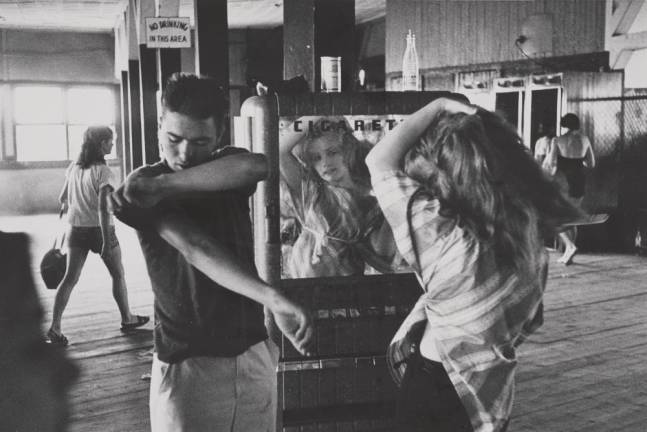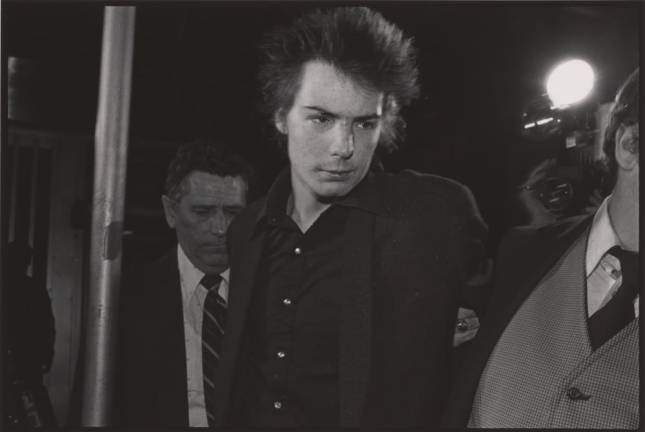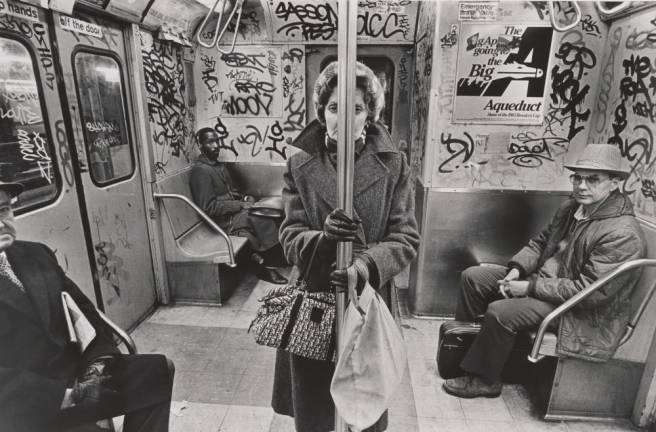Peter Stuyvesant’s map of his farm property. Milton Glaser’s “I [Heart] New York More Than Ever” poster following 9/11. A coffee dispenser from Horn & Hardart. A pillbox hat designed by the late Bill Cunningham, “William J.” A New Year’s Eve invite for an inaugural ride on the Second Avenue Subway — and a silver tray mapping surveillance cameras in Manhattan.
These material emblems of New York, plus 172 photographs of the city and its citizens, are on view in “Collecting New York’s Stories,” an exhibit in two parts that beautifully showcases recent acquisitions at the Museum of the City of New York.
The artifacts are quite tactile and in some cases throwaways that fortuitously found their way to the museum. They are testaments to the everyday lives of everyday people in the teeming metropolis.
“I think that a lot of people have one view of New York,” said curator Lindsay Turley, who organized the objects in the Tiffany Gallery. “They think of going to Broadway plays every night. New York is Times Square. It’s the Empire State Building. It’s going to the Statue of Liberty. It’s really fantastic to be able to present the view here in our galleries that the lives that people lead while residents of the city is not all glitz and glam. We do a lot of the same things that people do across the country—we work, we figure out which garments to wear each day.”
Bobby Pins, Post-its and More
One of the choicest bits of city history can be glimpsed in a Depression-era cosmetology set, owned by Sylvia Green Greenseid, a 1936 graduate of the Manhattan Evening Trade School. The kit boasts metal hair rollers, a curling iron, bobby pins, scissors and a nail file. Said Turley: “It’s a fabulous story. Sylvia Greenseid got her degree right after middle school. She went on to become a working woman in the 1940s. We didn’t have a lot of material in our collection that could speak to the experience of a woman worker in the 20th century.”
Lately, the focus at MCNY has been on building out some of the more contemporary areas of the collection. “We’re also really conscious that we are striving to tell all of New York’s stories, so we are thinking about all different types of New Yorkers, not just people who are most likely to save things from exclusive events,” Turley said.
The wall at the entryway to the artifacts gallery is festooned with posters, including a hand-made sign from the January 2017 New York City Women’s March — “Respect Us” — with a drawing of a diverse group of women and young girls linking arms in solidarity.
The 2016 Presidential contest figures in another piece, artist Matthew “Levee” Chavez’s “Subway Therapy,” a project initiated the day after the controversial election. Chavez handed out sticky notes and pens and encouraged straphangers to express themselves in the 14th Street pedestrian tunnel.
The venting spread like wildfire and resulted in 50,000 notes, a selection captured here in a photomural, along with some of the original Post-its. A sampling of sentiments: “Love is the answer,” “My uterus, my rules,” “Hope is good, but action is better.”
Ordinary and Not-So-Ordinary People
The visual storytelling continues in an adjacent gallery devoted to photos acquired within the last three years, most of them dating from the 1980s to the present. Well-known photographers like James Van Der Zee, Aaron Siskind and Bruce Davidson share the stage with lesser-knowns like Ruben Natal-San Miguel, Robert Gerhardt and Mitchell Hartman.
There’s a decided focus on people versus places, but that’s not to say the city’s architecture and the Brooklyn Bridge are not represented. They’re here, too.
But the spotlight is on ordinary, and some not-so-ordinary, people livin’ in the city, the bulk in Harlem, the East Village and the outer boroughs. Allan Tannenbaum photographed John Lennon and Yoko Ono in front of the Dakota (1980), Deborah Harry and Chris Stein of Blondie on a roof (1980), and Sex Pistols bassist Sid Vicious after his arrest for the murder of his girlfriend at the Hotel Chelsea (1978).
Milt Hinton’s photos of jazz legends and Yousuf Karsh’s vintage portrait of the Marx Brothers notwithstanding, the rest capture a cross-section of anonymous folk — young and old, native and immigrant, Black, Asian and Caucasian.
Social and Economic Diversity
Photo curator Sean Corcoran points to four photos from the go-go Eighties by Richard Sandler that highlight the city’s historic wealth gap. Two picture well-heeled pedestrians on Fifth Avenue — ladies in fur coats and a man and woman in front of Van Cleef & Arpels — the remainder take us below ground to the graffiti-saturated subways. A solitary man reads a newspaper in one image, a woman holds onto a subway pole that obscures her face in another.
Mitchell Hartman’s scenes of Queens’ residents bring us into the 21st century and capture “food carts and street life, a slice of life in a particular neighborhood,” Corcoran said. “I think particularly for out-of-towners, there’s an impression of New York as a mythic city. We want to show a city of communities and neighborhoods with social and economic diversity, to reflect the varied ways of living that take place here.”
IF YOU GO
What: “Collecting New York’s Stories: Stuyvesant to Sid Vicious”
Where: Museum of the City of New York, 1220 Fifth Avenue (at 103rd Street) mcny.org
When: Through December 31.


![The Many Lives of a City “I [Heart] New York More Than Ever,” 2001. Museum of the City of New York. Gift of Milton Glaser, 2019.27.3](http://www.ourtownny.com/binrepository/274x432/0c0/0d0/none/3492552/NFBS/mcny-3_4-458162_20200206150956.jpg)
